Unplugged: Sky Team (Boardgame)
 It looked like a scene from a bad TSA checkpoint at last year’s Gen Con when a long line of people queued up to demo the buzz-laden two player cooperative game, Sky Team. Sky Team has two players, a pilot and co-pilot, each place four dice on a central instrument board in an attempt to successfully land a plane. At the start of a round, players can discuss overall strategy, but once they’ve rolled their dice for the round no further talking is permitted. Players must manage the plane roll (tilt), fire the engines, lower the flaps, lower the landing gear, engage the brakes, and clear the path of other planes. Fail to do any of the above and the plane crashes. All this must be accomplished as the plane’s elevation ticks downward. If everything is set by the time the plane hits 0000, the plane lands successfully. Designed with heavy input from licensed pilots it should appeal to pilots, wannabe pilots, and anyone looking for a relatively short but solid two player co-op game.
It looked like a scene from a bad TSA checkpoint at last year’s Gen Con when a long line of people queued up to demo the buzz-laden two player cooperative game, Sky Team. Sky Team has two players, a pilot and co-pilot, each place four dice on a central instrument board in an attempt to successfully land a plane. At the start of a round, players can discuss overall strategy, but once they’ve rolled their dice for the round no further talking is permitted. Players must manage the plane roll (tilt), fire the engines, lower the flaps, lower the landing gear, engage the brakes, and clear the path of other planes. Fail to do any of the above and the plane crashes. All this must be accomplished as the plane’s elevation ticks downward. If everything is set by the time the plane hits 0000, the plane lands successfully. Designed with heavy input from licensed pilots it should appeal to pilots, wannabe pilots, and anyone looking for a relatively short but solid two player co-op game.
Sky Team
Designer: Luc Remond
Publisher: Scorpion Masque
Players: 2
Age: 12+
Time: 15 minutes
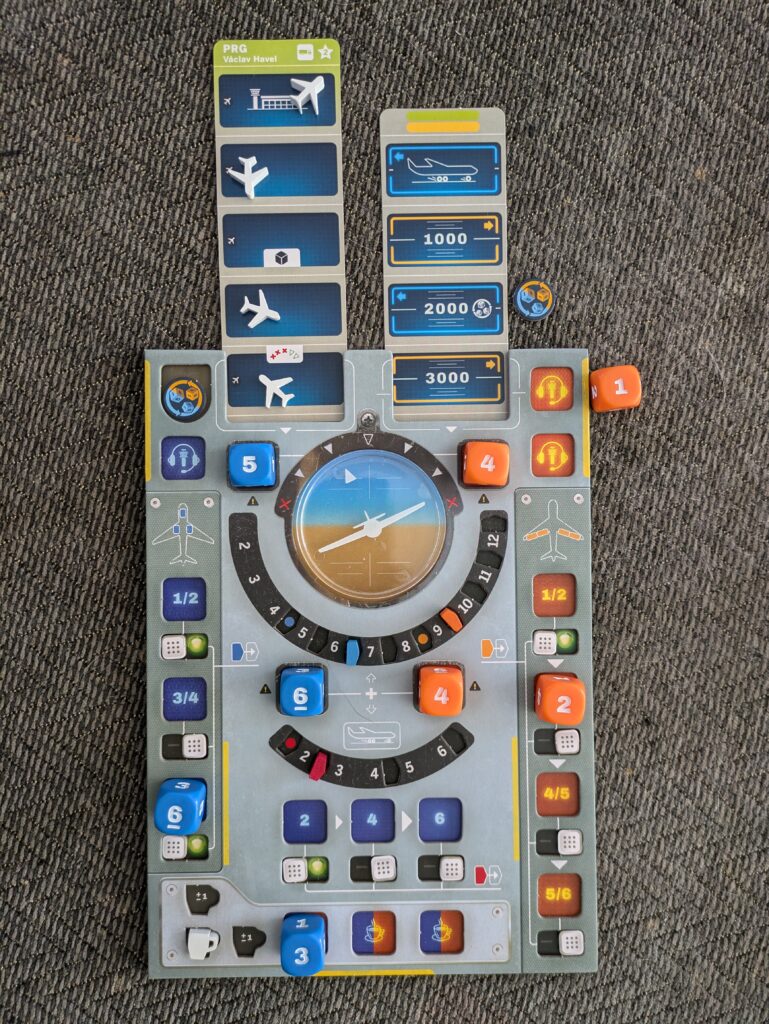
The full board mid-game.
To start the game, lay out the board and decide where you want to land your plane. The game comes with a dozen or so possible real-world airports and each airport has an easier and a more difficult option. Difficulties run from green (easy) through yellow, red, and black. Each airport has its own idiosyncrasies that tend to have a fun tie-in to situations at the real world airport. Above the top left of the display is the strip indicating the flight path, often with airplanes in the way – which need to be removed before they’re encountered. As players use the engines, this strip is slid under the display to keep track of the plane’s approach. This strip is reduced zero, one, or two spaces each round, depending on the dice placed. At the top right, the plane’s elevation serves as a timer. Each round the elevation goes down by 1000. When it hits 0000 the plane must have arrived at the airport or it crashes. The elevation also displays who places dice first that particular round and shows if/when players may gain a reroll token – usable at any time for both players to reroll any number of unused dice.
Once the game is set up, the pilot and copilot secretly roll their four dice and then take turns placing dice onto the game board. Slots are coded blue for the pilot and orange for the co-pilot. There are only a few spots (double-colored) that accept dice from either player.
There are seven locations that interact with the dice, with one location specific to each player. Thus, players have four dice to place into 6 possible locations. Players MUST play onto the engines and axis each turn so that leaves two “spare” rolls to take care of everything else that needs to be done.
The possible actions are:
- Axis (required) – Players must combine their dice to keep the plane level based on the difference.
- Engines (required) – Players determine speed by adding the two dice together.
- Radio – Place dice to remove planes from flight path.
- Landing Gear (Pilot only) – Lower three landing gear in any order.
- Flaps (Copilot only) – Lower Flaps in order top to bottom.
- Breaks (Pilot Only) – Engage breaks to increase chance of a successful stop.
- Concentration Coffee! – Spend any die to use a +/- 1 token on any future turn.
Let’s look at each action in turn:
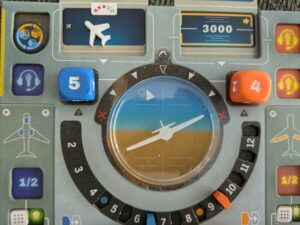
Axis (center) and Radios (top left and right)
Both players must place a die in their respective axis slot. This can happen at any time during the round, but when the second die is placed, the airplane immediately tilts based on the difference between the dice. In the above photo, the plane will tilt one slot to the left. If the airplane ever tilts more than two notches to one side or the other, the plane crashes. Upon arrival at the airport, the plane must be completely level or the plane crashes. In some advanced scenarios, players may be forced to tilt the plane one direction or another during the approach (or it crashes…)
Above and to each side of the axis display are spots to contact the radio tower. The pilot has one spot while the copilot has two spots. Dice are placed here to remove any airplanes that are on the flight path toward the airport. The number placed indicates the location where an airplane is removed.
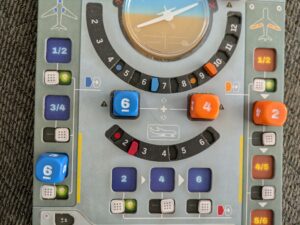
Left – Landing Gear, Center top – Engines, Center bottom – Breaks, Right – Flaps
The other must-place location are the engines. Here the sum of the two dice are used to determine how many locations forward the airplane will move. When the second die is placed, the total is compared to the engine track just above it. If the dice total is between the small orange and blue indicators, the plane moves forward one space. (Hopefully you’ve already removed any planes in the way using your radios – or you crash.)
The pilot has three slots for landing gear. When placed in a slot, that landing gear is turned on. These can be triggered in any order but need to all be active when the plane lands. Each time landing gear is activated, the blue marker on the engine track is moved ahead one space. This means that, as landing gear is lowered, the engines need to be at a higher setting to move 1 space.
The co-pilot has four slots for the flaps. All four must all be turned on before landing (or you crash) and must be turned on in order from top to bottom. Each time another flap is lowered, the orange marker on the engine track is moved ahead one space. This means it becomes more difficult for the airplane to move two spaces as more flaps are lowered. The landing gear and the flaps combine to adjust the plane’s flight such that it becomes more and more difficult for the plane to move forward. For a scenario with a long landing pattern, players had better move quickly at the start of the game.
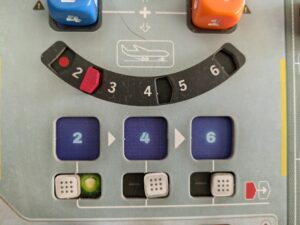
Breaks
After all this, if the plane actually manages to land at the right time at the right elevation, on the right axis, it still has to come to a complete stop. During the game, the pilot can assign dice to the breaks. This is done sequentially and moves the red marker one space to the right. On the final round, rather than the engines dictating how far the plane moves, it determines whether the brakes work. If the total of the placed dice are less than the brakes value, the plane comes to a stop and everyone wins. Applause from the passengers. If your engine total is above that, you crash. Note, the pilot needs to engage the breaks at least once (you can’t get less than a 2 on two dice) but they’re not forced to unlock the other breaks – it just gets harder to come to a safe stop.
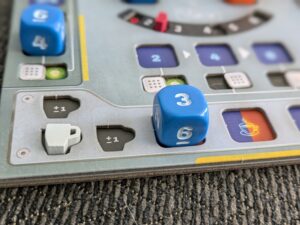
Everyone likes a cup of coffee.
If all this sounds tricky, it is. Players can lose the game if they crash on landing or run into an airplane already on the tarmac. If the dice aren’t rolling your way, some can be spent on getting coffee. A cup of coffee can be used later to modify a die that just isn’t cooperating. Players can store up to three cups of coffee and can use as many or as few as they wish all in one go.
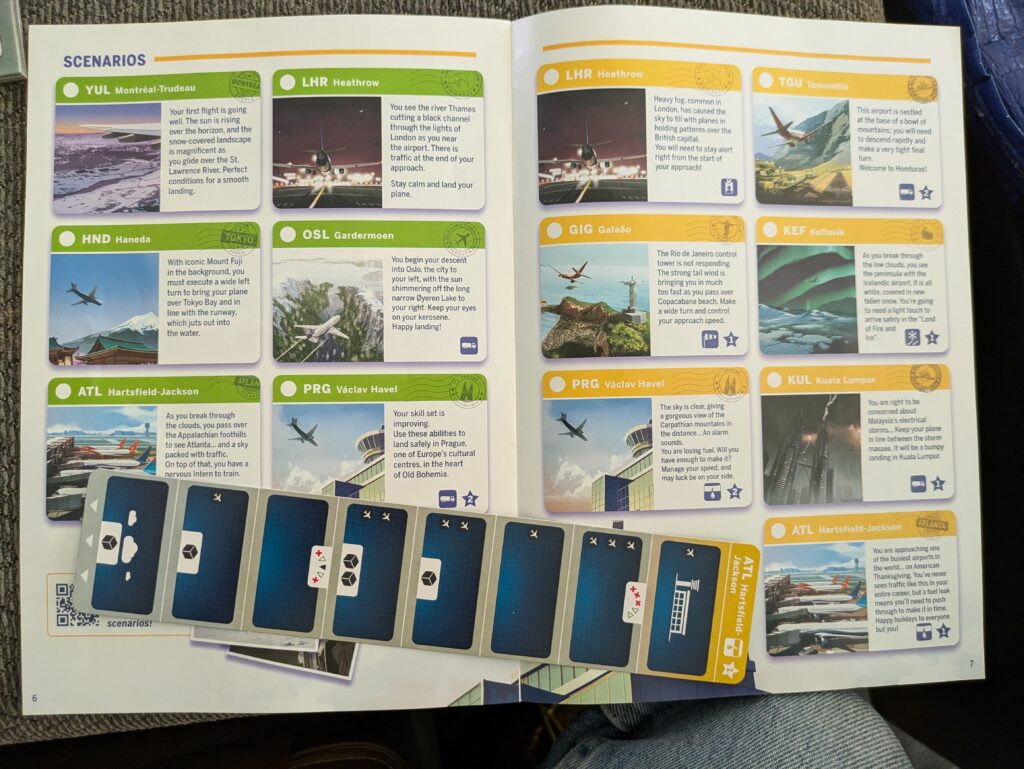
Lots of challenges to try.
Each different airport provides a different challenge. They range in order of increasing difficulty: green, to yellow, red, and black. Most airports have an easier and a harder size. They usually have a nice thematic tie-in to the airport in question. Landing in the mountains requires tricky maneuvering, northern cities might have you land on an icy runway, etc…
Notice the black dice on the landing pattern for the Atlanta airport. When a black die is encountered on the landing path, a special black die is rolled and an additional plane is added to the flight path – time to get back on that radio!
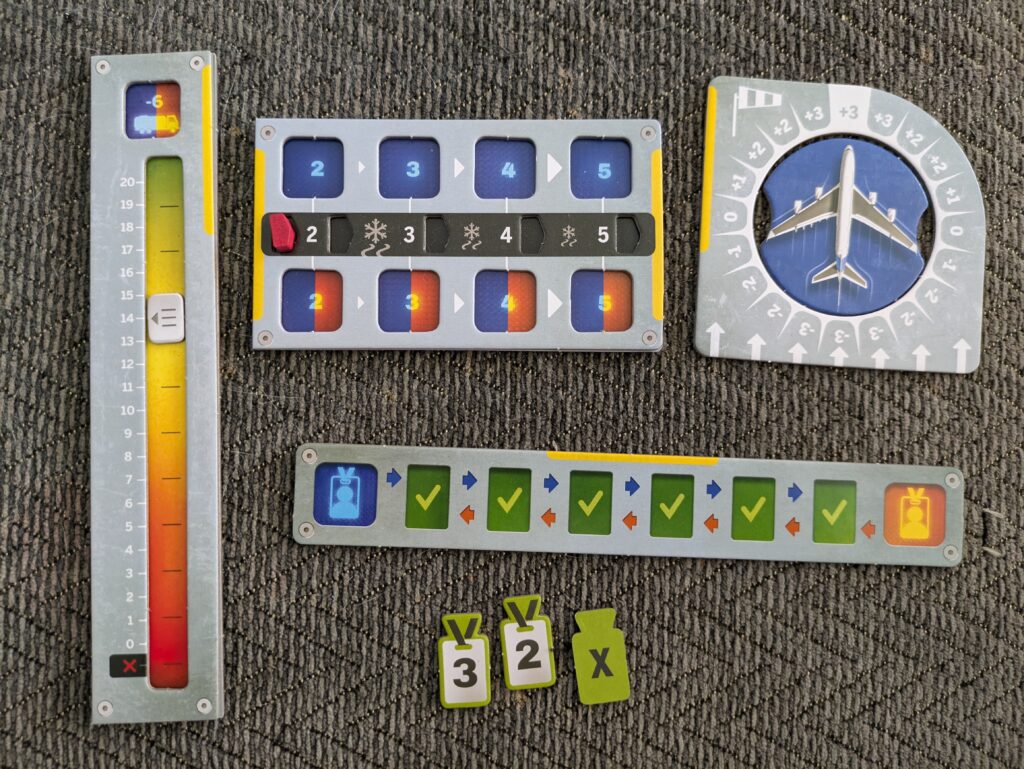
Expansions, clockwise from left: Fuel Reserves, Icy Runway, Wind Speeds, and Interns.
And If that isn’t tricky enough for you, there are several modules that can be added in to increase difficulty. The different difficulties range from easy, medium, hard to expert. There are 10 new destinations, all of which adjust whether the runway is shorter, longer, or require the plan to adjust its tilt on the way in. Players can have to deal with a leaking fuel tank, wind blowing the plane around, icy runways, and even the presence of an intern on the board, in place of a die. These extra modules require more timely placement of dice and are a bit less forgiving with bad rolls.
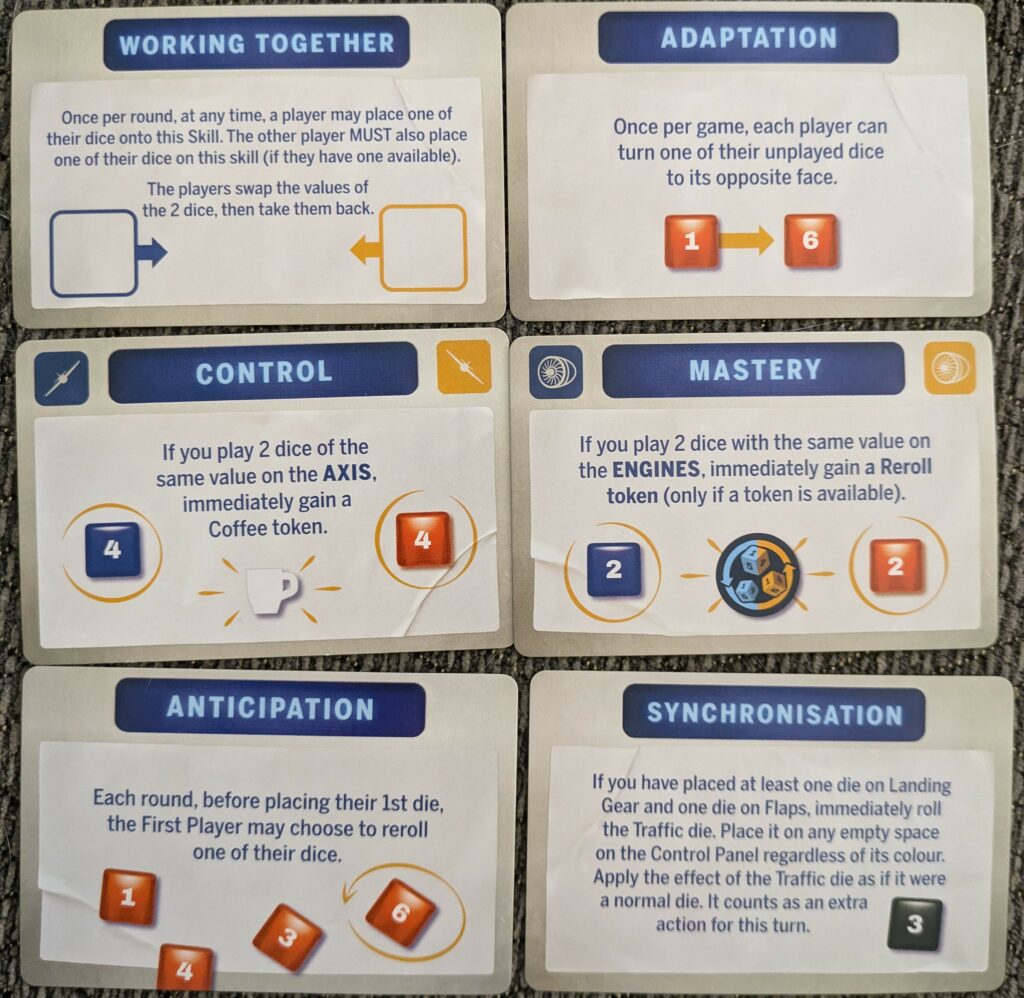
Some challenges provide a bonus ability to help you out.
Some scenarios allow players to access special ability cards. One (or more) are drawn and can be used during the game to try to help the players overcome all the other nasty stuff that is thrown their way.
Verdict:
 I’m a big fan of this game, there’s so much to like here. It’s a co-op game that avoids any quarterbacking due to the limit on communication during the round. It’s a small box (yay!) so it fits on my shelves and is easy to bring along with me on trips. The theme is excellently done, all the “stuff” that has to be done landing a plane is here and players have to fiddle with it. The landing gear and flaps slow the plane, just like in “real life” so even that mechanism is spot-on.
I’m a big fan of this game, there’s so much to like here. It’s a co-op game that avoids any quarterbacking due to the limit on communication during the round. It’s a small box (yay!) so it fits on my shelves and is easy to bring along with me on trips. The theme is excellently done, all the “stuff” that has to be done landing a plane is here and players have to fiddle with it. The landing gear and flaps slow the plane, just like in “real life” so even that mechanism is spot-on.
Yes, the dice are randomizers but between reroll tokens and coffee there are often a few options to try to help mitigate complete disaster. That said, some harder levels will just not go your way. Thankfully the short play time comes to the rescue and you can just try again.
The early scenarios are fairly easy to complete but do a great job teaching the game. Since it’s so short, most of the time I play we will immediately have another go at a harder level (if we completed the first one successfully.) I love how the scenarios match the airports – if you have a favorite/hated airport you can have a go at landing there, adjusting to typical problems if you choose the more challenging side. I could eventually see myself tiring of the base game if it weren’t for the included expansion modules. I’m not someone who has time to play a game into the ground so I’ll be very happy to get at least a few dozen plays out of the game.
I’m putting this squarely in the “I Love It” camp and I do not see it leaving my collection soon. I’ve even had a preview of the upcoming expansion for the game. One of its features is messing with how players roll their dice each round – it seemed to me to be a fine fit with the rest of the difficulty options.
Kid Factor:
The only thing to worry about here is the complexity. There’s not any reading to worry about so any kid who can follow along with what needs to be done should be OK. If needed, parents could ignore the “no talking” rule and/or play some of the easiest scenarios to make it work with even younger kids.





Discussion Area - Leave a Comment